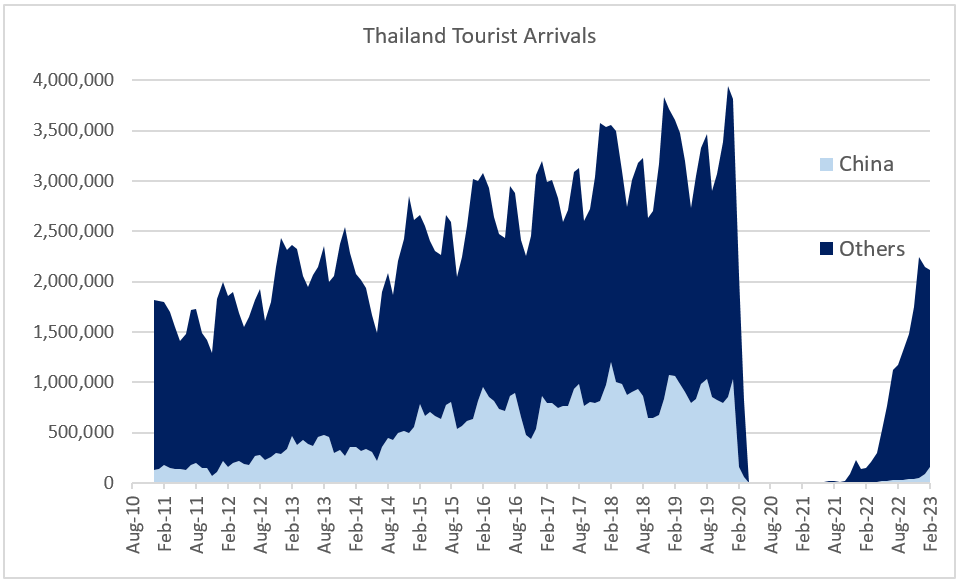EM Growth Drivers – Clash of Titans
27 March 2023
Read Time 2 MIN
Recession Concerns
The market expectations for the U.S. Federal Reserve (Fed) remain stubbornly dovish, with the banking system’s turmoil emerging as the main culprit – especially as regards the impact of tighter lending conditions on the growth outlook. The Fed’s senior loan officer opinion survey shows that tightening was already underway going into the banking mini-crisis, but the share of “considerable tightening” was still small – so this space warrants close attention in the coming weeks. Most observers agree that spillovers from the developed markets (DM) banking turmoil into emerging markets (EM) should be limited – another supporting factor for the asset class in addition to lower debt ratios and much higher real rates. However, we might need to exercise caution when interpreting the latest EM activity gauges - which are just around the corner – given the timing of the mini-crisis.
China Rebound
Another factor to keep in mind when thinking about the EM growth outlook is that the credit impulse is now negative in about one-half of major EMs (in addition to being “barely there” in about 1/3, according to the sell-side estimates). This is, of course, a consequence of EM central banks’ early and aggressive policy tightening in response to the post-pandemic price pressures, but this raises the importance of China as a potential global growth “booster”. The recent sharp increase in China’s economic surprise index looks encouraging – the index is now the highest since 2006 – but the consensus prefers to be the cautious. Both the services and the manufacturing PMIs are expected to stay comfortably in expansion zone, but without further improvement.
China Reopening and EM Growth
The latest signals in EM manufacturing suggest that China’s growth boost to EM growth is likely to materialize later this year – for now, numbers show mostly marginal improvements and signs of stabilization. Thailand’s tourism arrivals show that the impact of China’s reopening on services – especially in EM Asia – might also take time. While it is true that the number of Chinese tourists tripled since December, the improvement is from a near-zero base, and well below the pre-pandemic levels (see chart below). Stay tuned!
Chart at a Glance: China’s Growth Boost to EM – Patience, Please

Source: Bloomberg LP
Related Insights
IMPORTANT DEFINITIONS & DISCLOSURES
This material may only be used outside of the United States.
This is not an offer to buy or sell, or a recommendation of any offer to buy or sell any of the securities mentioned herein. Fund holdings will vary. For a complete list of holdings in VanEck Mutual Funds and VanEck ETFs, please visit our website at www.vaneck.com.
The information presented does not involve the rendering of personalized investment, financial, legal, or tax advice. Certain statements contained herein may constitute projections, forecasts and other forward looking statements, which do not reflect actual results. Information provided by third-party sources are believed to be reliable and have not been independently verified for accuracy or completeness and cannot be guaranteed. Any opinions, projections, forecasts, and forward-looking statements presented herein are valid as of the date of this communication and are subject to change without notice. The information herein represents the opinion of the author(s), but not necessarily those of VanEck.
The views contained herein are not to be taken as advice or a recommendation to buy or sell any investment in any jurisdiction, nor is it a commitment from Van Eck Associates Corporation or its subsidiaries to participate in any transactions in any companies mentioned herein. This content is published in the United States. Investors are subject to securities and tax regulations within their applicable jurisdictions that are not addressed herein.
All investing is subject to risk, including the possible loss of the money you invest. As with any investment strategy, there is no guarantee that investment objectives will be met and investors may lose money. Diversification does not ensure a profit or protect against a loss in a declining market. Past performance is no guarantee of future results.
